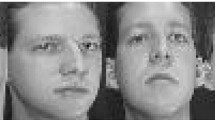Abstract
Fuzzy linear discriminate analysis (FLDA), the principle of which is the remedy of class means via fuzzy optimization, is proven to be an effective feature extraction approach for face recognition. However, some of the between-class distances in the projected space after FLDA may be too small, which can render some classes inseparable. In this paper we propose a weighted FLDA approach that aims to increase the smallest of the between-class distances. This is accomplished by introducing some weighting coefficients to the between-class distances in FLDA. Since the optimal selection of these weighting coefficients is not tractable via standard optimization techniques, the genetic algorithm is adopted as an alternative solution in this paper. The experimental results on some benchmark data sets reveal that the proposed weighted fuzzy LDA can improve the worst recognition rate effectively and also exceed LDA and FLDA’s average performance index.






Similar content being viewed by others
References
Zhao W, Chellappa R, Phillips PJ, Rosenfeld A (2003) Face recognition: a literature survey. ACM Comput Surv 35(4):399–458
Chellaappa R, Wilson CL, Sirohey S (1995) Human and machine recognition of faces: a survey. In: Proceedings IEEE, vol. 83, pp. 705–740
Turk M (2001) A random walk through eigenspace. IEICE Trans Inform Syst E84-D:1586–1695
Phillips PJ, Flynn PJ, Scruggs T, Bowyer KW et al. (2005) Overview of the face recognition grand challenge. In: Proceedings IEEE conference computer vision and pattern recognition, pp 947–954
Francis BA (1987) A course in H∞ control theory. Springer, New York
Belhumeur PN, Hespanha JP, Kriegman DJ (1997) Eigenfaces versus fisherfaces: recognition using class specific linear projection. IEEE Trans Pattern Anal Machine Intell 19:711–720
Yu H, Yang J (2001) A direct LDA algorithm for high-dimensional data with application to face recognition. Pattern Recognit 34:2067–2070
Gao H, Davis JW (2006) Why direct LDA is not equivalent to LDA. Pattern Recognit 39(5):1002–1006
Ye J, Xiong T (2006) Null space versus orthogonal linear discriminant analysis. In: Proceedings of the 23rd international conference on Machine learning, pp 1073–1080
Mika S, Rätsch G, Weston J, Schölkopf B, Müller K-R (1999) Fisher discriminant analysis with kernels. In: IEEE international workshop on neural networks for signal processing IX, pp 41–48
Yang J, Frangi AF, Yang J, Zhang D, Jin Z (2005) KPCA plus LDA: a complete kernel Fisher discriminant framework for feature extraction and recognition. IEEE Trans Pattern Anal Machine Intell 230–244
Kwak KC, Pedrycz W (2005) Face recognition using a fuzzy fisherface classifier. Pattern Recognit 38:1717–1732
Yang W, Yan H, Wang J, Yang J (2008) Face recognition using complete fuzzy LDA. In: International conference on pattern recognition, pp 1–4
Lotlikar R, Kothari R (2007) Fractional-step dimensionality reduction. IEEE Trans Pattern Anal Machine Intell 22(6):623–627
Koren Y, Carmel L (2004) Robust linear dimensionality reduction. IEEE Trans Visual Comput Graph 10(4):459–470
Yale Univ. Face Database (2002) http://cvc.yale.edu/projects/yalefaces/yalefaces.html
Georghiades A, Belhumeur P, Kriegman D (2005) From few to many: illumination cone models for face recognition undervariable lighting and pose. IEEE Trans Pattern Anal Mach Intell 23(6):643–660
Lee K, Ho J, Kriegman D (2005) Acquiring linear subspaces for face recognition under variable lighting. IEEE Trans Pattern Anal Mach Intell 27(5):684–698
Extended Yale Database B, http://vision.ucsd.edu/~leekc/ExtYaleDatabase/ExtYaleB.html
AT&T Lab Cambridge. The ORL Database, http://www.cam-orl.co.uk/facedatabase.html
Phillips PJ, Moon H, Rizvi SA, Rauss PJ (2000) The FERET evaluation methodology for face-recognition algorithms. IEEE Trans Pattern Anal Machine Intell 22(10):1090–1104
Sim T, Baker S, Bsat M (2003) The CMU pose, illumination, and expression database. IEEE Trans Pattern Anal Machine Intell 1615–1618
Parsopoulos KE, Vrahatis MN (2011) Particle swarm optimization method for constrained optimization problems. Optimization 181:1153–1163
Duarte A, Martí R, Glover F, Gortazar F (2011) Hybrid scatter tabu search for unconstrained global optimization. Ann Operations Res 183(1):95–123
He J, Hou Z (2011) Ant colony algorithm for a class of non-differentiable optimization problems. In: International conference on electronic and mechanical engineering and information technology, vol. 5, pp 2644–2647
Author information
Authors and Affiliations
Corresponding author
Rights and permissions
About this article
Cite this article
Xue, M., Liu, W. & Liu, X. A novel weighted fuzzy LDA for face recognition using the genetic algorithm. Neural Comput & Applic 22, 1531–1541 (2013). https://doi.org/10.1007/s00521-012-0962-x
Received:
Accepted:
Published:
Issue Date:
DOI: https://doi.org/10.1007/s00521-012-0962-x




